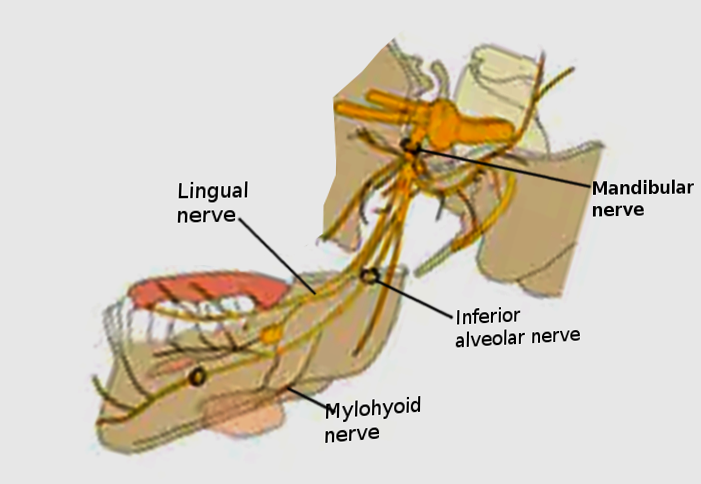[2]
Hsiao TH, Chang HP. Anatomical variations in the digastric muscle. The Kaohsiung journal of medical sciences. 2019 Feb:35(2):83-86. doi: 10.1002/kjm2.12012. Epub
[PubMed PMID: 30848024]
[3]
Choi P, Iwanaga J, Dupont G, Oskouian RJ, Tubbs RS. Clinical anatomy of the nerve to the mylohyoid. Anatomy & cell biology. 2019 Mar:52(1):12-16. doi: 10.5115/acb.2019.52.1.12. Epub 2019 Mar 29
[PubMed PMID: 30984446]
[5]
Bennett S, Townsend G. Distribution of the mylohyoid nerve: anatomical variability and clinical implications. Australian endodontic journal : the journal of the Australian Society of Endodontology Inc. 2001 Dec:27(3):109-11
[PubMed PMID: 12360663]
[6]
Iwanaga J, Kikuta S, Oskouian RJ, Tubbs RS. Nerve to mylohyoid branched from the lingual nerve: previously undescribed case. Anatomical science international. 2019 Jun:94(3):266-268. doi: 10.1007/s12565-019-00476-4. Epub 2019 Feb 1
[PubMed PMID: 30710312]
Level 3 (low-level) evidence
[7]
Sinha P, Tamang BK, Sarda RK. Communication between Mylohyoid and Lingual Nerve: An Anatomical Variation. Journal of clinical and diagnostic research : JCDR. 2014 Apr:8(4):AD01-2. doi: 10.7860/JCDR/2014/7560.4223. Epub 2014 Apr 15
[PubMed PMID: 24959428]
[8]
Potu BK, D'Silva SS, Thejodhar P, Jattanna NC. An unusual communication between the mylohyoid and lingual nerves in man: its significance in lingual nerve injury. Indian journal of dental research : official publication of Indian Society for Dental Research. 2010 Jan-Mar:21(1):141-2. doi: 10.4103/0970-9290.62792. Epub
[PubMed PMID: 20427927]
[9]
Altug HA, Sencimen M, Varol A, Kocabiyik N, Dogan N, Gulses A. The efficacy of mylohyoid nerve anesthesia in dental implant placement at the edentulous posterior mandibular ridge. The Journal of oral implantology. 2012 Apr:38(2):141-7. doi: 10.1563/AAID-JOI-D-10-00037. Epub 2010 Jul 21
[PubMed PMID: 20662675]
[10]
Forbes WC. Twelve alternatives to the traditional inferior alveolar nerve block. The Journal of the Michigan Dental Association. 2005 May:87(5):52-6, 58, 75
[PubMed PMID: 16224870]
[11]
Nilesh K, Naniwadekar RG, Malik NA. Large plunging schwannoma of the floor of the mouth involving the mylohyoid nerve: a case report and review of the literature. General dentistry. 2016 May-Jun:64(3):33-6
[PubMed PMID: 27148654]
Level 3 (low-level) evidence
[12]
Pattani KM, Dowden K, Nathan CO. A unique case of a sublingual-space schwannoma arising from the mylohyoid nerve. Ear, nose, & throat journal. 2010 Jul:89(7):E31-3
[PubMed PMID: 20628977]
Level 3 (low-level) evidence

